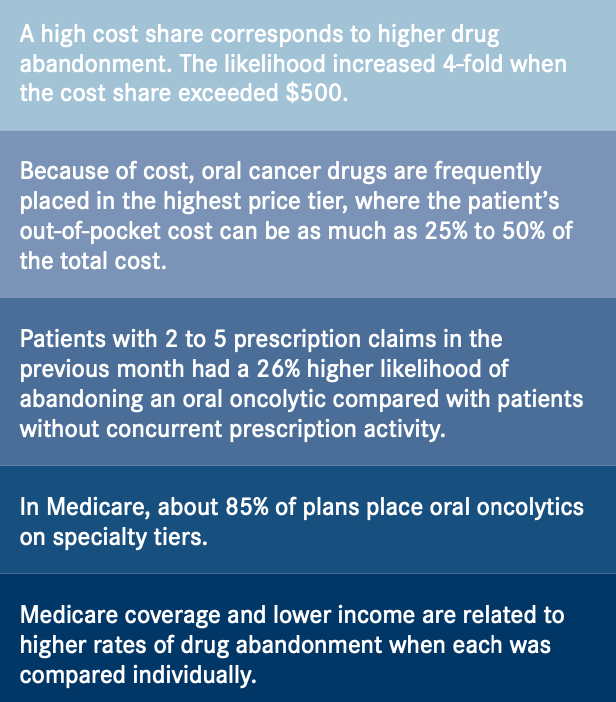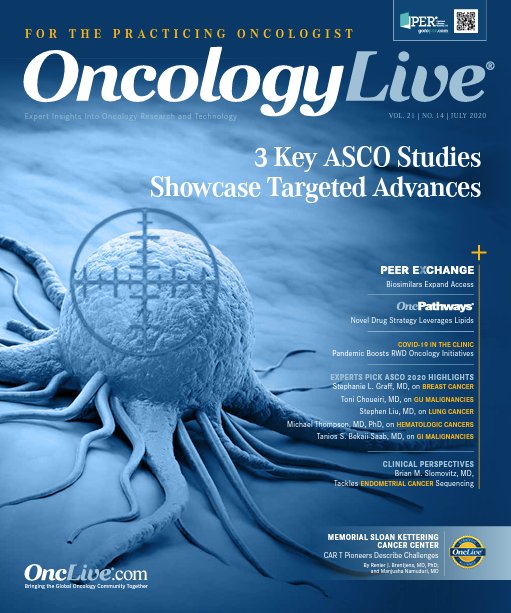Publication
Article
Oral Oncolytics Will Require Health Care System to Adapt
Author(s):
Judging from the drug pipeline, the future of oncology is oral chemotherapy.

Judging from the drug pipeline, the future of oncology is oral chemotherapy. These agents make up 25% to 35% of oncology drugs in development.1 It’s clear that in 5 to 10 years, oral therapies likely will be a much larger component of potential treatment plans for patients with cancer.
The question is: How will our health care system adapt to this shifting paradigm? Although most intravenous (IV) cancer treatments are covered under the medical component of health insurance plans, oral oncolytics typically fall under the prescription drug component, which often results in a consider- able disparity in cost.
For Medicare patients, IV therapies are covered under Part B benefits; however, oral cancer drugs are generally covered by Medicare Part D. Under the Affordable Care Act, the Medicare Part D benefit now includes coverage in the coverage gap, known as the donut hole.
Patients continue to have challenges with medication access because of out-of- pocket expenses.
The cost for new oral cancer drugs is in the range of $10,000 per month. Payers are shifting management of these drugs to their pharmacy benefit managers (PBMs), and PBMs further control costs by limiting dispensing through specific specialty/mail order pharmacies. PBMs also place oral cancer drugs into cost-sharing tiers with variable co-pay expectations for patients.
Overall, more of the cost burden of cancer care is being shifted to patients.2 The percentage of patients with cancer unable to access their therapies due to cost is expected to increase over the next 10 years (TABLE).3
Addressing the insurance and payer coverage of oral oncology medications and ensuring patient access has been a priority of many organizations.
For example, the Community Oncology Alliance recently issued a position statement that supports the passage of an oral parity law on the federal level, a central theme being the need for more comprehensive protection than what state laws can provide.4
So far, to protect patients, 43 states have passed oral parity laws, which are designed to ensure that oral cancer therapies are no less affordable than their injectable counterparts. These laws differ significantly from state to state.3
For example, some state laws pertain only to health care plans that are state regulated. Additionally, states achieve parity in slightly different ways, leaving millions of Americans with non–state-regulated plans unprotected.
Passing the Cancer Drug Parity Act of 2019, a bill introduced in the US House of Representatives in March 2019, would ensure that patients can expect to face the same cost-sharing model for oral cancer-fighting pills that they do for IV therapies.
Activity on this bill, however, appears to be on hold because of the coronavirus disease 2019 pandemic.
The Rise of Oral Oncolytics
Oral cancer-fighting medications are not entirely new. Molecular targeted therapies,such as tamoxifen for hormone-receptor positive breast cancer, have been around for more than 40 years. A record number of oncology drugs launched in 2018, bringing new options to patients and continuing the transformation of treatment patterns occurring from the introduction of immunotherapies less than 5 years ago. These new drugs use diverse mechanisms to treat cancer and include 3 immunooncology therapies. Over half of the new therapies are delivered as an oral formulation, have an orphan indication, or include a predictive biomarker on their label.
Additionally, in 2019, the FDA’s Center for Drug Evaluation and Research approved 11 new novel therapies for oncology; 8 were oral oncolytics.5 Although oral therapies are not adverse event (AE) free, many formulations allow for a better quality of life and fewer AEs, such as the hair loss and high toxicity that come with systemic chemotherapy.
Uncertainty remains regarding the use of oral oncology agents. For example, how do we make sure patients adhere to treatment regimens? Oncology providers, and community practices in particular, must take a leading role in evolving and adapting to ensure the full benefit and potential of oral chemotherapeutic agents are realized in the patient experience.
Patient access to therapies is another area of deep concern, because a disparity of cost share between orals and injectables can directly affect quality of care. Treatment decisions and options are dependent on drug coverage, and a higher cost share for oral drugs could push patients toward less effective therapies. This is not a question of brand versus generic drugs, because oral drugs present a different therapy pathway.
Leaving patients vulnerable to financial toxicity can have a negative effect on health outcomes and add burden to practices that dedicate staff, and therefore cost, to work on the patient’s behalf to find financial assis- tance through discount programs and charitable organizations. Clearly, the insurance cost share should be the same whether a therapy is administered orally or intravenously. What matters is that the therapy is medically necessary and that the patient receives the safest and most effective therapy available for their diagnosis.
Waves of New Legislation
The move toward oral parity is also in line with a growing trend toward passing legis- lation, on both the federal and state level, that is designed to reduce the cost of all prescription drugs. Americans spend more on pharmaceuticals than ever before; health spending and prescription drug price growth are expected to surpass that of the gross domestic product.
This mounting crisis has resulted in some significant congressional actions and proposals on drug pricing, many of which have bipartisan support. Congress has closed the Medicare Part D donut hole, requiring pharma manufacturers to pay 70% of the brand name drug costs for beneficiaries in the coverage gap.6
Legislation has also been passed to repeal “gag orders,” banning contracts that don’t allow pharmacists to tell patients how they could pay less for medicine.
National health spending is projected to grow at an average annual rate of 5.4% for 2019-2028 and reach $6.2 trillion by 2028.
Among major payers, Medicare is expected to experience the fastest spending growth (7.6% per year over 2019-2028), largely as a result of having the highest projected enrollment growth.
Additionally, the insured share of the population is expected to fall from 90.6% in 2018 to 89.4% by 2028.7
Currently, both the Senate and House are considering reduced out-of-pocket maximum proposals for Medicare Part D.
There is also consensus around passing a federal bill that would protect patients from “surprise medical billing” from out-of-network providers, such as when a patient cannot choose the emergency department, physicians, or ambulance provider.
The White House under President Trump has proposed the American Patients First drug pricing blueprint to reduce the cost of prescription drugs. The US Department of Health and Human Services has gone so far as to propose a model that is fraught with unintended consequences, all in the name of setting certain drug prices based on an international benchmark.
These are big steps, and they’re being taken with the patient in mind, with the sole intent of lowering out-of-pocket costs. Policy makers may have differing opinions on how to get there, but all are reaching for the same end goal: to reduce the cost burden of prescription drugs on consumers.
When it comes to cancer care, treatment pathways are undergoing a sea change as targeted oral therapies replace systemic, injectable chemotherapies. In 5 to 10 years, IV therapies may no longer be an option for certain cancers.
Our health care system needs to adapt accordingly, because we can’t have a system that puts patients at a disadvantage. Addressing this issue now is a necessary next step to keeping the system equitable and putting the patient first.
Table. Patients Face Financial Barriers to Accessing Oral Oncolytics3

Mark Alwardt is vice president of specialty pharmacy at McKesson; Ben Jones is vice president, government relations and public policy at McKesson; and Valerie A. Russo, PharmD, is director of in-office dispensing operations at McKesson.
References
- Stokes M, Reyes C, Xia Y, Alas V, Goertz HP, Boulanger L. Impact of pharmacy channel on adherence to oral oncolytics. BMC Health Serv Res. 2017;17(1):414. doi:10.1186/s12913-017-2373-2
- Egerton NJ. In-office dispensing of oral oncolytics: a continuity of care and cost mitigation model for cancer patients. Am J Manag Care. 2016;22(suppl 4):S99-S103.
- Fact sheet: patient Access to oral oncolytics. Community Oncology Alliance. September 17, 2019. Accessed May 20, 2020. https://communityoncology.org/pdfs/fact-sheet-oral-oncolytics.pdf
- COA oral parity position statement. Community Oncology Alliance. September 17, 2019. Accessed May 20, 2020. https://communityoncology.org/coa-oral-parity-position-statement/
- New drug therapy approvals 2019. FDA. Updated January 6, 2020. Accessed May 20, 2020. bit.ly/2LLKjuQ
- Costs in the coverage gap. Medicare.gov. Accessed May 27, 2020. bit.ly/2ZFo5T9
- NHE fact sheet. Updated March 24, 2020. Centers for Medicare & Medicaid Services. Accessed May 20, 2020. https://go.cms.gov/2Zpilge









